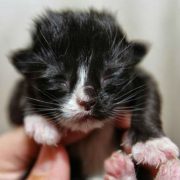It’s an Early Start to Kitten Season
While we used to only have to worry about an influx of kittens during the spring and summer months, kitten season seems to be coming earlier and earlier every year. DAWS already has its first litter of kittens in foster care, and that means our Cat and Foster Programs are ramping up for what we are anticipating will be a very busy season. There are a number of theories about why we are seeing longer kitten seasons, but there are no clear answers to that question. Regardless of the reasons, DAWS, like many other shelters across the country, will do its best to care for the many mamas and kittens that will need our help this year.
Cats differ from dogs in that they do not have heat cycles at regular intervals throughout the year. Instead, cats come into heat seasonally, based on a number of factors. These conditions include the number of daylight hours, rising temperatures, the presence of other cats, and when other conditions are optimal. With at least 10 hours of daylight and other optimal conditions, a cat’s hormonal system is activated and the reproductive cycle is initiated. The mating season for cats in the Northern Hemisphere traditionally begins in March and extends through September, but this has been getting longer over the years.
Some experts have been investigating whether warmer temperatures across the globe are not only affecting glaciers and sea levels, but also the heat cycle of cats. The Environmental Protection Agency has stated that rising temperatures may cause some small mammals to breed earlier. While many disagree that this theory applies to cats, stating that the heat cycle in cats is more closely related to the number of daylight hours to which a cat is exposed versus temperature, rising temperatures could create other conditions that may contribute to a longer mating season. For example, warmer temperatures may make prey animals (mice/rats) more available earlier in the year, giving cats a more reliable food source to support them in an extended mating season. And, warmer weather can increase kitten survival rate, lending to more kittens earlier in the year.
Whatever the underlying cause, an extended kitten season puts extra burden on shelters around the country, including DAWS. Here are some ways that you can help us during kitten season:
Become a Kitten Foster
Young animals, including kittens cannot be housed in our shelter because their immune systems are not fully developed, and they would be at risk for illness. That means we rely on foster families to open up their homes and care for kittens until they are ready for adoption. Being a foster parent is a rewarding experience, and helps save lives. Refer to information on our Foster Care page to learn how you can foster kittens.
Donate
With an influx of kittens, our need for kitten food, kitten milk, and litter increases exponentially. Your generous donation of these items, or donations of gift cards or money to purchase them, helps ensure these kittens are well cared for before they find homes.
Trap-Neuter-Return
Helping to control the number of unwanted litters starts with altering cats. You can help reduce the number of feral cats that give birth to litters of kittens by supporting our Trap-Neuter-Return program. Humanely trapping cats and bringing them in to DAWS or other local shelters to be altered is a great way to reduce the number of kittens born during kitten season.
As always, spaying/neutering your own animals is incredibly important to eliminating unplanned and unwanted litters of kittens. Make sure all of your pets are altered to avoid a mishap.



